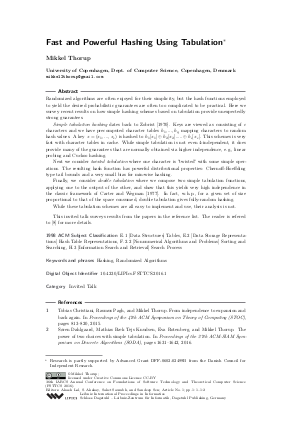Fast and Powerful Hashing Using Tabulation (Invited Talk)
Author Mikkel Thorup
-
Part of:
Volume:
36th IARCS Annual Conference on Foundations of Software Technology and Theoretical Computer Science (FSTTCS 2016)
Part of: Series: Leibniz International Proceedings in Informatics (LIPIcs)
Part of: Conference: IARCS Annual Conference on Foundations of Software Technology and Theoretical Computer Science (FSTTCS) - License:
 Creative Commons Attribution 3.0 Unported license
Creative Commons Attribution 3.0 Unported license
- Publication Date: 2016-12-10
File

PDF
LIPIcs.FSTTCS.2016.1.pdf
- Filesize: 295 kB
- 2 pages
Document Identifiers
Subject Classification
Keywords
- Hashing
- Randomized Algorithms
Metrics
- Access Statistics
-
Total Accesses (updated on a weekly basis)
0PDF Downloads0Metadata Views
Abstract
Randomized algorithms are often enjoyed for their simplicity, but the hash functions employed to yield the desired probabilistic guarantees are often too complicated to be practical. Here we survey recent results on how simple hashing schemes based on tabulation provide unexpectedly strong guarantees. Simple tabulation hashing dates back to Zobrist [1970]. Keys are viewed as consisting of c characters and we have precomputed character tables h_1, ... , h_q mapping characters to random hash values. A key x = (x_1 , ..., x_c) is hashed to h_1[x_1] + h_2[x_2] ... + h_c[x_c]. This scheme is very fast with character tables in cache. While simple tabulation is not even 4-independent, it does provide many of the guarantees that are normally obtained via higher independence, e.g., linear probing and Cuckoo hashing. Next we consider twisted tabulation where one character is "twisted" with some simple operations. The resulting hash function has powerful distributional properties: Chernoff-Hoeffding type tail bounds and a very small bias for min-wise hashing. Finally, we consider double tabulation where we compose two simple tabulation functions, applying one to the output of the other, and show that this yields very high independence in the classic framework of Carter and Wegman [1977]. In fact, w.h.p., for a given set of size proportional to that of the space consumed, double tabulation gives fully-random hashing. While these tabulation schemes are all easy to implement and use, their analysis is not.
Cite As Get BibTex
Mikkel Thorup. Fast and Powerful Hashing Using Tabulation (Invited Talk). In 36th IARCS Annual Conference on Foundations of Software Technology and Theoretical Computer Science (FSTTCS 2016). Leibniz International Proceedings in Informatics (LIPIcs), Volume 65, pp. 1:1-1:2, Schloss Dagstuhl – Leibniz-Zentrum für Informatik (2016)
https://doi.org/10.4230/LIPIcs.FSTTCS.2016.1
BibTex
@InProceedings{thorup:LIPIcs.FSTTCS.2016.1,
author = {Thorup, Mikkel},
title = {{Fast and Powerful Hashing Using Tabulation}},
booktitle = {36th IARCS Annual Conference on Foundations of Software Technology and Theoretical Computer Science (FSTTCS 2016)},
pages = {1:1--1:2},
series = {Leibniz International Proceedings in Informatics (LIPIcs)},
ISBN = {978-3-95977-027-9},
ISSN = {1868-8969},
year = {2016},
volume = {65},
editor = {Lal, Akash and Akshay, S. and Saurabh, Saket and Sen, Sandeep},
publisher = {Schloss Dagstuhl -- Leibniz-Zentrum f{\"u}r Informatik},
address = {Dagstuhl, Germany},
URL = {https://drops.dagstuhl.de/entities/document/10.4230/LIPIcs.FSTTCS.2016.1},
URN = {urn:nbn:de:0030-drops-68869},
doi = {10.4230/LIPIcs.FSTTCS.2016.1},
annote = {Keywords: Hashing, Randomized Algorithms}
}
